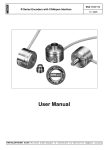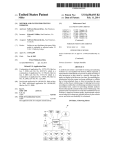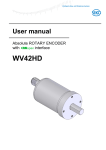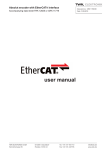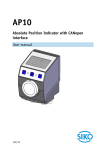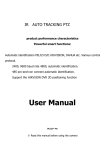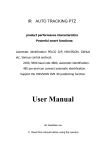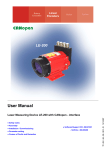Download Operating Instructions - TWK
Transcript
Encoder CRN as a subscriber in CANopen Accompanying data sheet: CRN 10636 CRN/C 10750 BE 12 / 99 Operating Instructions TWK-ELEKTRONIK GmbH · D-40041 Düsseldorf · PF. 10 50 63 · T. 02 11/63 20 67 · F. 02 11/63 77 05 · e-mail: [email protected] · http://www.twk.de 0. Table of contents Page 0. Table of contents ............................................................................................................ 2 - 4 1. General ............................................................................................................................ 5 2. CANopen Communication Concept ............................................................................. 5 - 6 3. CANopen Scope of the TWK Encoder .......................................................................... 6 4. Network Management .................................................................................................... 7 - 8 4.1 Minimum-Capability-Device Boot up........................................................................ 7 4.2 Description of the NMT Commands ........................................................................ 8 5. Node Guarding................................................................................................................ 8 - 9 6. Bus Synchronisation ...................................................................................................... 10 7. Emergency Message-supported Error Codes ............................................................. 10 8. Installation Instructions ................................................................................................. 11 - 12 9. 10. 8.1 Node - ID, Baudrate, Terminal Resistor ................................................................... 11 8.2 LED Description ...................................................................................................... 12 The Object Directory ...................................................................................................... 12 - 15 9.1 Subdivision of the Object Directory ......................................................................... 12 9.2 Services for Writing and Reading the Object Directory ........................................... 12 9.3 COB-ID structure .................................................................................................... 13 9.4 Message Objects and Function Codes ................................................................... 13 9.5 The Command Byte describes the Type of SDO Message ..................................... 14 9.6 Examples of Service Data Objects ......................................................................... 15 Communication Profile .................................................................................................. 16 - 34 10.1 Object 1000H: Device Type ..................................................................................... 16 - 17 10.2 Object 1001H: Error Register .................................................................................. 17 10.3 Object 1002H: Manufacturer Status Register .......................................................... 18 10.4 Object 1003H: Predefined Error Field ...................................................................... 19 10.5 Object 1004H: Number of PDOs supported ............................................................ 20 10.6 Object 1005H: COB-ID SYNC-Message ................................................................ 21 10.7 Object 1006H: Communication Cycle Period .......................................................... 22 -2- 0. Table of contents 11. 10.8 Object 1007H: Synchronous Window Length ............................................ 22 10.9 Object 1008H: Device Name ..................................................................... 23 10.10 Object 1009H: Manufacturer Hardware Version ........................................ 23 10.11 Object 100AH: Manufacturer Software Version ......................................... 24 10.12 Object 100BH: Node-ID ............................................................................. 24 10.13 Object 100CH: Guard Time ....................................................................... 25 10.14 Object 100DH: Life Time Factor ................................................................. 25 10.15 Object 100EH: Node Guarding Identifier ................................................... 26 10.16 Object 100FH: Number of SDO´s supported ............................................ 26 - 27 10.17 Object 1010H: Store Parameters ............................................................... 27 10.18 Object 1011H: Restore Default Parameters .............................................. 28 10.19 Object 1014H: COB-ID Emergency Message ........................................... 29 10.20 Overview of Transmission Types ............................................................... 29 10.21 Object 1800H: 1st Transmit PDO (asynchronous transmission) ............... 30 - 31 10.22 Object 1A00H: 1st Transmit PDO (asynchronous transmission) Mapping 32 10.23 Object 1802H: 2nd Transmit PDO (synchronous transmission) ................ 33 10.24 Object 1A02H: 2nd Transmit PDO (asynchronous transmission) Mapping34 Encoder Profile ............................................................................................................... 35 11.1 Encoder Parameter .................................................................................... 35 11.1.1 Object 6000H: Operating Parameters ........................................................ 35 - 36 11.1.2 Object 6001H: Measuring Units per Revolution ......................................... 36 11.1.3 Object 6002H: Total Measuring Range ...................................................... 37 11.1.4 Object 6003H: Preset Value ....................................................................... 38 11.1.5 Object 6004H: Position Value ..................................................................... 38 - 39 11.1.6 Object 6200H: Cyclic Timer ....................................................................... 39 11.1.7 Object 6400H: Area State Register ........................................................... 40 11.1.8 Object 6401H: Work Area low limit ............................................................ 41 -3- 0. Table of contents 11.1.9 Object 6402H: Work Area high limit ...................................................... 42 11.2. Encoder Diagnostics............................................................................. 43 11.2.1 Object 6500H: Operating Status ........................................................... 43 11.2.2 Object 6501H: Single Turn Resolution ................................................... 44 11.2.3 Object 6502H: Number of distinguishable Revolutions ......................... 44 - 45 11.2.4 Object 6503H: Alarms ........................................................................... 45 11.2.5 Object 6504H: Supported Alarms ......................................................... 45 11.2.6 Object 6505H: Warnings ....................................................................... 46 11.2.7 Object 6506H: Supported Warnings ...................................................... 46 11.2.8 Object 6507H: Profile and Software Version ......................................... 47 11.2.9 Object 6508H: Operating Time .............................................................. 47 11.2.10 Object 6509H: Offset Value ................................................................... 48 11.2.11 Object 650AH: Module Identification ..................................................... 49 11.2.12 Object 650BH: Serial Number ............................................................... 50 11.3 Manufacturer-specific Profile Area ........................................................ 50 11.3.1 Object 2000H: Node ID (Plug Version) ................................................. 51 11.3.2 Object 2001H: Baudrate (Plug Version) ................................................ 52 12. Default Values for Programming Parameters ..................................................... 52 - 54 13. Store Parameters (Object 1010H) ........................................................................ 54 14. Literature ................................................................................................................ 54 COPYRIGHT: The Operating Instructions CRN/C 10750 is owned by TWK-ELEKTRONIK GMBH and is protected by copyright laws and international treaty provisions. © 1999 by TWK-ELEKTRONIK GMBH POB 10 50 63 n 40041 Düsseldorf n Germany Tel. +49/211/63 20 67 n Fax +49/211/63 77 05 e-mail: [email protected] n http://www.twk.de -4- 1. General 1. 2. CANopen Communication Concept General The use of the CAN philosophy in industrial automation has led to the necessity of equipping encoders with this interface. The basic prerequisites for the rapid expansion of the CAN-bus in industrial use have been the positive examples of application within the automobile industry, and the availability of inexpensive ICs from various manufacturers. The CANopen profile has been developed on the basis of the CAN Application Layer (CAL); also see OSI model. This CAL-based communication profile for industrial systems is defined in CiA Draft Standard 301. At this point, it should be mentioned that other profile definitions (e.g. DeviceNet, SDS, CANKingdom, etc.) are available on the market in addition to the CANopen profile. The profile definitions for various devices have been drawn up according to the CANopen definition. The Device Profile for Encoders in CiA Draft Proposal 406 has been adopted for encoders. The TWK encoder has been developed on the basis of the existing standard. In each case, Class 1 and Class 2 functionality have been implemented. The latter contains the programmable version for encoders. The profile is described in detail in the operating instructions. The prerequisite, however, is exact knowledge of the CAL and the CANopen profile. 2. CANopen Communication Profile The different communication objects and communication services, and the different start and stop conditions for message transmission within a CANopen network are described in the DS 301, CANopen, Communication Profile. CANopen supports the transmission of synchronous and asynchronous messages. As a result of synchronous message transmission, network-wide data capture and processing with universal reference is possible.Defined communication objects for this purpose are (SYNC-message, Time Stamp Message).The transmission of the synchronisation object is carried out via the SYNC-master, which controls network-wide data capture, processing and transmission. Asynchronous messages are result-dependent and may be transmitted at any desired point in time. Differentiation is made between four functionally-dependent message groups: - Administration Messages (Layer Management, Network Management, Identifier Distribution Management) - Service Data Messages - Process Data Messages - Pre-defined Messages (Synchronisation, Time Stamp, Emergency) Administration Messages refer to those messages which are exchanged on use of CAL services for network configuration, network administration and identifier allocation. The services and protocols LMT, NMT, DBT and CMS, and are contained in the CAL standard.The Service Data Messages are exchanged in the event of direct write or read access to object directory entries. The objects which are to be exchanged are designated as the Service Data Object. The main application of this type of message is in device configuration.The real-time transmission of current process data is realised with the Process Data Messages. The objects which are transferred are designated as the Process Data Object. The fundamental characteristics of PDO and SDO are compared in the following table. -5- 3. CANopen Scope of the TWK Encoder Process Data Object PDO Service Data Object SDO Is used for real-time data exchange. No real-time data exchange. Enables access to any desired object directory entry. The SDO makes a peer-to-peer communication channel available. Is typically a high-priority message: Is generally a low-priority message. Can be transmitted both synchronously and Transmission is typically asynchronous and is confirmed asynchronously: with a service. Both cyclical and acyclical message transmission are Acyclical transmission. Transmission is initiated by the possible. client. The data content of the PDO is defined in the object Use of the data field is determined by the CMS Multiplexed directory, and can be configured via an SDO. Domain Protocol. Data field format is specified. Access to an object directory entry of a device is carried out by specifying index and subindex (direct addressing). 3. - CANopen scope of the TWK Encoder According to Device Profile DS 406 NMT-slave One SDO per communication direction for accessing Two PDOs per communication direction the object directory PDO modes: synchronous / asynchronous Identifier setting via Node ID (default) PDO-Identifier can be adjusted via SDO COB-ID distribution: default SYNC message EMERGENCY message Node guarding Simple boot-up according to DS 301 Transmission Types can be adjusted for all PDOs CAN-LED support for bus state DIP-switch support for setting the node address (6bits) and the Baudrate (2 bits) for the connecting cap version Node ID and Baudrate setting across manufacturer-specific object range by means of SDO Encoder programming parameters: Code sequence, single turn resolution, total measuring range in measuring units, preset value, lower and upper work area Schematic circuit diagram CAN-TRANSCEIVER Foto GaAlAs Dioden transistoren CAN Controller µController-System Multi-Funktions ASIC CAN + CAN CAN GND DC DC + US - US Opto Analog Array Asic -6- 4. Network Management 4. Network Management 4.1 Minimum-Capability-Device Boot up The encoders are designed as Minimum Capability Devices according to CANopen (see CiA-DS 302), i.e. they behave according to the following state diagram: For switching between the different states, the following CANopen services are required or are independently carried out by the encoder: power on 6 Initialisation 5 4 Pre-Operation 3 5 3 1 5 Operational 2 Prepared 4 1 2 4 (1) (2) Start Remote Node (start the CANopen node) Stop Remote Node (stop the CANopen node) (3) (4) Enter Pre-Operational (switch to pre-operational) Reset Node (reset the entire CANopen node) (5) (6) Reset Communication (reset CANopen node communication) Initialisation finished (initialisation terminated, automatic change of state to pre- operational) In this case, it must be noted that the state Prepared must not be used on Boot-up. The individual states can be described as follows: Initialisation: Initial state following application of the supply voltage. After running through the initialisation routines, the encoder automatically switches to Pre-Operational state. Pre-Operational: The node can be addressed via SDO messages under the standard identifier. The encoder and communication parameters can be programmed. Operational: The encoder is active. The position value of the encoder is output via the PDOs. Prepared: In this state, the node is no longer active, i.e. both SDO and PDO communication are impossible. The encoder can be set to the Operational or Pre-Operational state via the corresponding NMT commands. The most simple method of starting an encoder as a CANopen subscriber is to execute the Start Remote Node service. In doing so, the encoder is brought into its Operational state. -7- 4. Network Management 5. Node Guarding 4.2 Description of the NMT Commands The NMT object is structured as follows: Byte0 COB-ID = 0 Command byte cs Byte1 Node ID* * If a 0 is entered for the node ID, the service is transmitted to all subscribers. Command byte Description cs = 1 cs = 2 Start Remote Node: Switch to Operational Stop Remote Node: Switch to Prepared cs = 128 cs = 129 Enter Pre-Operational State: Switch to Pre-operational Reset Node1) cs = 130 Reset Communication2) 1) 2) The parameters of the entire object directory are set to power-on values The parameters of the object director y, communication profile section, are set to poweron values. Example of switching nodes with node ID 1 to active: Master -> Slave ID DLC NMTZeroMsg 2 (=0) (Software: CANalyzer) Data Byte 0 1 Byte 1 1 Slave -> Master No confirmation or acknowledgement! 5. Node Guarding The guarding of subscribers in the bus, especially in the case of event-controlled processes, is a sensible feature. A differentiation is made between lifeguarding and node guarding. In the case of lifeguarding, the NMT-master is also guarded by the NMT-slaves, in addition to the guarding of the slaves by the NMT-master. Node Guarding alone is implemented in the encoder. This means that the NMT-master guards the NMT-slave via corresponding services. On activation of node guarding, the network master transmits an RTR-telegram with the COB-ID for node guarding (700H + node ID) to the node at regular intervals (guard time). The slave-NMT responds under COB-ID with the status in Byte 0. -8- 5. Node Guarding Byte 0 Bit 7 Bit 6 Bit 7: Bit 0-6: Bit 5 Bit 4 Bit 3 Bit 2 Bit 1 Bit 0 Toggle-Bit If this bit does not change between two successive responses, an error has occurred. The value at the start (1st response) of guarding is „0“. (The toggle bit is switched in the case of successive data frames, in order to guarantee that the application, and not only the CAN-Controller, responds to guarding) Status 4: Prepared 5: Operational 127: Pre-Operational The guard time (object 100CH), multiplied with the life time factor (object 100DH), reveals the life time period for the node guarding protocol. If the subscriber does not respond within the life time period, corresponding application-specific precautions must be implemented. An example of this is, e.g., the implementation of a change of state from Operational to Prepared for the defective node. Example: 1. Guard time (100CH) and life time factor (100DH) = 0 Encoder in state: Operational NMT-guarding (e.g. Id:702 DLC: R1 Data: 0 see CANalyzer) 1st response: Data: 05H NMT-guarding (e.g. Id:702 DLC: R1 Data: 0 see CANalyzer) 2nd response: Data: 85H NMT-guarding (e.g. Id:702 DLC: R1 Data: 0 see CANalyzer) 3rd response: Data: 05H 2. Guard time (100CH) = 100H and life time factor (100DH) = 1H Encoder in state: Operational 1st NMT-guarding (e.g. Id:702 DLC: R1 Data: 0 see CANalyzer) within the life time 1st response: Data: 05H 2nd NMT-guarding (e.g. Id:702 DLC: R1 Data: 0 see CANalyzer) within the life time 2nd response: Data: 85H 3rd NMT-guarding (e.g. Id:702 DLC: R1 Data: 0 see CANalyzer) within the life time 3rd response: Data: 05H 4th NMT-guarding (e.g. Id:702 DLC: R1 Data: 0 see CANalyzer) time 4th response: Data: FFH Encoder independently switches into Pre-Operational state! Changes in state on failure of guarding: Prepared Operational Pre-Operational -> -> -> Pre-Operational Pre-Operational Pre-Operational -9- not within the life 6. Bus Synchronisation 7. Emergency Message-supported Error Codes 6. Bus Synchronisation The CANopen communication profile enables the synchronisation of subscribers in the bus. In this case, the SYNCmessage (also see object 1005H, default value = 80H) serves to provide synchronisation between the various bus subscribers. In the case of real-time applications, certain procedures must be time-synchronised and must run in certain pre-specified time windows. The time between two SYNC-telegrams is described as the communication cycle. Within a communication cycle, differentiation is made between the report window (actual values: e.g. actual encoder position values, I/O module) and command window (nominal values or initial values: e.g. commands to drives, actuation command for actuators) time windows. The nominal values and commands become actual in the case of the next SYNC-telegram. Following the SYNC-window, low-priority messages are able to access the bus. Communication_Cycle_Period synchronous windows length SYNC Message SYNC Message Actual_ Messages Actual_ Messages Command Messages Samples taken at SYNC for ACTUAL message Command Messages Actuation based on COMMAND at next SYNC 7. Emergency Message-supported Error Codes In the event of an error, an emergency telegram is output via the COB-ID emergency message (see object: 1014H standard: 80H + node-ID). This contains the emergency error code (byte 0,1), see below and the error register (byte 2). The error register is described under object 1001H. Emergency Error code (hex) 0000 5000 5100 8100 Designation Comment Error reset or no error Device hardware Hardware memory error Communication FFFF Device-specific Error reset or no error present MSA and/or expander error ROM code error Communication error (Master - Encoder communication e.g. interrupted) Manufacturer-specific: see object 6503 Alarms Object 6503 Alarms Meaning in the case of emergency message FFFFH Bit Bit 11-0 Bit 12 Bit 13 Bit 14 Bit 15 Designation/value 0 EEPROM error CRC error EEPROM XRAM error 0 Supported no yes yes yes no Object 6504 Supported Alarms (see above) - 10 - 8.Installation Instructions 8. Installation Instructions 8.1 Node ID, Baudrate, Terminal Resistor Connecting cap version: DIP-switch: DIP-switch ON OFF 1 2 3 4 5 6 7 8 9 10 x x x x x x x x x x Configuration: Range of values Example Value + 1 = Node ID = 3 Node ID: Switch 1 - 6 1-64 Baudrate: Switch 7-8 0x0 20 kBaud 0x1 125 kBaud 0x2 500 kBaud 0x3 1MBaud On On Terminal Resistor: Switch 9-10 20 kBaud Terminal resistor switched on (see example) Off Off Terminal resistor not switched on Plug version: Default values (on delivery) Value range: Baudrate: 20 kBaud Default address: 1 Baudrate 0x0 20 kBaud 0x1 125 kBaud 0x2 500 kBaud 0x3 1MBaud Node address: 1 - 64 Procedure on changing parameters: 1. Edit parameter (object: 2000H Node address 2001H Baudrate) 2. Store parameter (object 1010H “SAVE”) 3. Reset node 4. New parameter values are actual - 11 - 8. Installation Instructions 9. The Object Directory 8.2 LED Description: UB green ON Data green COM green Err red Comment Operating voltage present Process data communication CAN communication OK. CAN communication Warning state CAN communication BUS OFF Error which triggers the Emergency Protocol or SDO Abort Transfer Protocol flash ON flash OFF ON 9. The Object Directory 9.1 Subdivision of the Object Directory Index (hex) 0000 0001-001F 0020-003F 0040-005F 0060-0FFF 1000-1FFF 2000-5FFF 6000-9FFF Object unused static data types complex data types manufacturer-specific data types reserved communication profile manufacturer-specific profile standardised device profile A000-FFFF reserved 9.2 Services for Writing and Reading the Object Directory Access to the object directory of the encoder is carried out via SDO messages. The device and communication-specific parameters of the encoder are described in the object directory The structure of the SDO message (expedited SDO, may 4 bytes) is as follows: COB-ID 11 bit Command Byte 0 Index Byte 1 Byte 2 (LSB) (MSB) Subindex Byte 3 Service data Byte 4 Byte 5 Byte 6 Byte 7 (LSB) (MSB) The following identifiers are available as standard for the SDO services: SDO (tx) (slave -> master): 580H (1408) + Node ID SDO (rx) (master -> slave): 600H (1536) + Node ID (Note: The SDO identifiers cannot be changed) - 12 - 9. The Object Directory 9.3 COB-ID Structure The COB-ID - COB identifier serves to clearly identify a CAN message. The data are transmitted throughout the network via communication objects (COB). The identifier is 11 bits wide, and is comprised of a 4 bit function code and a 7 bit node ID. The priority of a message decreases with an ascending COB identifier. COB-ID structure, see Predefined Master/Slave Connection Set according to CANopen: Bit No.: 10 9 8 7 6 5 4 Function code Node ID Assignment x x x x 0 x x x - 0 or 1 3 2 1 0 x x x x 9.4 Message Objects and Function Codes On use of the Predefined Master/Slave Connection Set (see DS 301 CANopen), the message identifiers are defined as follows: Object NMT SYNC Emergency PDO 1(tx) PDO 2(tx) SDO (tx) SDO (rx) Nodeguard Function code Resulting COB-ID Communication parameter CMS parameter from index priority (binary) Hexadecimal Decimal (hexadecimal) group 0000 0001 0001 0011 0101 1011 1100 1110 0 80 81-FF 181-1FF 281-2FF 581-5FF 601-67F 701-77F 1005 1800 1802 100E 0 0 0,1 1,2 2,3 6 6,7 - 0 128 129-255 385-511 641-767 1409-1535 1537-1663 1793-1919 - 13 - 9. The Object Directory 9.5 The Command Byte Describes the Type of SDO Message (see examples for SDOs) Command in hex Type Function 22 SDO (rx) Transmit parameter to encoder Initiate download request (data length max. 4 bytes) 23 SDO (rx) Transmit parameter to encoder Initiate download request (data length = 4 bytes) 2B SDO (rx) Transmit parameter to encoder Initiate download request (data length = 2 bytes) 2F SDO (rx) Transmit parameter to encoder Initiate download request (data length = 1 byte) 60 SDO (tx) Initiate download response Confirmation of take-over to master 40 SDO (rx) Initiate upload request Request parameter from encoder 43 SDO (rx) Initiate upload response Parameter to master with data length = 4 bytes (Unsigned 32) 4B SDO (rx) Initiate upload response Parameter to master with data length = 2 bytes (Unsigned 16) 4F SDO (rx) Initiate upload response Parameter to master with data length = 1 byte (Unsigned 8) 80 SDO (rx) Abort domain transfer Encoder reports error code to master - 14 - 9. The Object Directory 9.6 Examples of Service Data Objects Reading the object directory Master -> Slave COB-ID+ NodeID 600H + Node-ID Slave -> Master COB-ID+ NodeID 580H + Node-ID Byte0 Byte1 Byte2 Byte3 Byte4 Byte5 Byte6 Byte7 Index Subindex reserved 40H LSB MSB Byte0 Byte1 Byte2 Byte3 Byte4 Byte5 Byte6 Byte7 Index Subindex reserved 42H LSB MSB Example: Reading the position value (object 6004H) COB-ID+ NodeID 601 581 Byte0 Byte1 Byte2 Byte3 40 04 60 00 43 04 60 00 Byte4 Byte5 Byte6 Byte7 00 00 00 00 34 12 Writing the object directory Master -> Slave COB-ID + NodeID Byte0 Byte1 Byte2 Byte3 600H + Node-ID 22H Slave -> Master COB-ID + NodeID Byte0 Byte1 Byte2 Byte3 580H + Node-ID 60H Index LSB Subindex reserved MSB Index LSB Byte4 Byte5 Byte6 Byte7 Byte4 Byte5 Byte6 Byte7 Subindex reserved MSB Example: Writing the preset value 1000H (object 6003H) COB-ID+ NodeID 601 581 Byte0 Byte1 Byte2 Byte3 22 03 60 00 60 03 60 00 - 15 - Byte4 Byte5 Byte6 Byte7 00 10 00 00 00 10 10. Communication Profile 10. Communication Profile Communication Profile Overview / Communication-Profile Index (hex) 1000 1001 1002 1003 1004 1005 1008 1009 100A 100B 100C 100D 100E 100F 1010 1011 1014 Object Code VAR VAR VAR ARRAY ARRAY VAR VAR VAR VAR VAR VAR VAR VAR VAR VAR VAR VAR ObjectName Type Attr. C1 C2 Device type Error register Manufacturer status register Pre-defined error field Number of PDOs supported COB-ID SYNC-message Device name Hardware version Software version Node-ID Guard time Life time factor COB-ID guarding protocol Number of SDO´s supported Store parameters Restore Default Parameters COB-ID Emergency message unsigned32 unsigned8 unsigned32 unsigned32 unsigned32 unsigned32 Vis-String Vis-String Vis-String unsigned32 unsigned32 unsigned32 unsigned32 unsigned32 unsigned32 unsigned32 unsigned32 const ro ro ro ro rw const const const ro rw rw rw ro rw rw rw m m o o o o o o o o o o o o m m o o o o o o o o o o o o o m m o 1 st Transmit PDO (asynchronous transmission) 1800 1st transmit PDO Parameter PDO COMMPAR 1A00 TxPDO 1 Mapping PDO Mapping rw ro m o m o 2 nd Transmit PDO (synchronous transmission) 1802 2nd transmit PDO Parameter 1A02 TxPDO 2 Mapping rw ro m o m o PDO COMMPAR PDO Mapping 10.1 Object 1000H: Device Type Object 1000H Device Type The object 1000H contains the device profile number and the encoder type according to /1/ Object description Index Name Object Code Data Type 1000H Device Type VAR unsigned32 Value description Access Value Range Default Value ro (const) unsigned32 no - 16 - 10. Communication Profile Structure of the parameters Device Type Device Profile Number Byte 0 Byte 1 96 1 Encoder Type Byte 2 Byte 3 2 0 Multiturn absolute rotary encoder Description: Encoder: 0x00020196 10.2 Object 1001H: Error Register Object 1001H Error Register The error register displays encoder device errors. Object description Index Name Object Code Data Type 1001H Error Register VAR unsigned8 Value description Access Value Range Default Value ro unsigned8 0x0 (no Error) Description Bit 0 1 2 3 4 mandatory/ optional m o o o o 5 6 7 o o o Meaning supported generic error current voltage temperature communication error (overrun, error state,...) device profil specific reserved manufacturer specific yes no no no yes Default value: 00H (no error) - 17 - no no yes 10. Communication Profile 10.3 Object 1002H: Manufacturer Status Register Object 1002H Manufacturer Status Register This object is the manufacturer status register. Object description Index Name Object Code Data Type 1002H Manufacturer Status Register VAR unsigned32 Value description Access Value Range Default Value ro unsigned32 00H Description Not further supported at present. - 18 - 10. Communication Profile 10.4 Object 1003H: Predefined Error Field Object 1003H Predefined Error Field The device errors are entered into object 1003H. - Subindex 00H Number of Errors stored (max. 1). - Subindex 01H Each new error is stored under subindex 01. The error display is deleted by writing the value zero into subindex 00H (only when the error state has been eradicated). Object description Index Name Object Code Data Type 1003H Predefined Error Field Array unsigned32 Value description Sub-Index Description Access Value Range 00H Number of Errors rw unsigned8 Sub-Index Description Access Value Range Default Value 01H Standard Error Field ro unsigned32 00H Example: e.g. EEPROM error Error register Predefined Error Field Alarms 1001H 1003,00H 1003,01H 6503H 0x81 0x1 0x81FFFF 0x1000 1001H 1003,00H 1003,01H 6503H 0x0 0x0 0x0 0x0 e.g. no error Error register Predefined Error Field Alarms - 19 - 10. Communication Profile 10.5 Object 1004H: Number of PDOs Supported Object 1004H Number of PDOs supported Index 1004H contains the maximum number of PDOs which are supported by the encoder. Differentiation is made between synchronous/asynchronous and transmit/receive PDOs in this case. Object description Index Name Object Code Data Type 1004H Number of PDOs supported Array unsigned32 Value description Sub-Index Description Access Value Range Default Value 00H Number of PDOs supported ro unsigned32 0x2H Sub-Index Description 01H / 02H 01H: Number of synchronous PDOs 02H:Number of asynchronous PDOs Access Value Range Default Value ro unsigned32 0x1/ 0x1 Description Subindex 00H 01H 02H Subindex 00 01 02 MSB Number of receive PDOs Number of synchr. receive PDOs Number of asynchr. receive PDOs Value 02H 01H 01H LSB Number of transmit PDOs Number of synchr. transmit PDOs Number of asynchr. transmit PDOs Description 2 transmit PDOs 1 synchronous transmit PDO 1 asynchronous transmit PDO - 20 - 10. Communication Profile 10.6 Object 1005H: COB-ID SYNC Message Object 1005H COB-ID SYNC Message The object 1005H defines the COB-ID for the SYNC message (synchronisation message). In addition, it is defined whether the subscriber generates SYNC messages or merely reacts to SYNCs. Object description Index Name Object Code Data Type 1005H COB-ID SYNC Message VAR unsigned32 Value description Access Value Range Default Value rw unsigned32 80H Parameter structure Bit Value Meaning 31(MSB) 0 1 0 1 0 1 0 x x Device does not consume SYNC message Device consumes SYNC message Device does not generate SYNC message Device generates SYNC message 11-Bit ID (CAN 2.0A) 29-Bit ID (CAN 2.0B) if bit 29 = 0 if bit 29 = 1; Bits 28-11 of 29-bit-SYNC-COB-ID bits 10-0 of SYNC-COB-ID (Standard-ID = 80H) 30 29 28-11 10-0(LSB) Example Encoder 0x80000080 (Note: On changing the COB-ID, the current value only becomes valid following storage (see object 1010H) and subsequent encoder resetting). - 21 - 10. Communication Profile 10.7 Object 1006H: Communication Cycle Period Object 1006H Communication Cycle Period Object 1006H defines the communication cycle period in ms. If the value is 0, this object is not used. Object description Index Name Object Code Data Type Communication Cycle Period VAR unsigned32 Access Value Range Default Value rw unsigned32 0H Value description 1006H 10.8 Object 1007H: Synchronous Window Length Object 1007H Synchronous Window Length Object 1007H defines the synchronous window length parameter in ms. If the value is 0, this object is not used. Object description Index Name Object Code Data Type Synchronous Window Length VAR unsigned32 Access Value Range Default Value rw unsigned32 0H Value description 1007H - 22 - 10. Communication Profile 10.9 Object 1008H: Device Name Object 1008H Device Name Object 1008H contains the manufacturer-specific device name.˝ Object description Index Name Object Code Data Type 1008H Access Default Value ro Encoder CRN Value description Manufacturer Device Name VAR Visible String 10.10 Object 1009H: Manufacturer Hardware Version Object 1009H Manufacturer Hardware Version Object 1009H contains the hardware version number. Object description Index Name Object Code Data Type 1009H Manufacturer Hardware Version VAR Visible String Value description Access Default Value ro e.g. 01.00 - 23 - 10. Communication Profile 10.11 Object 100AH: Manufacturer Software Version Object 100AH Manufacturer Software Version Object 100AH contains the software version number. Object description Index Name Object Code Data Type Manufacturer Software Version VAR Visible String Access Default Value ro e.g. 01.40 Value description 100AH 10.12 Object 100BH: Node ID Object 100BH Node ID Object 100BH contains the node ID. Access to the node ID entry is of the “read only” type, and cannot be changed via SDO. This entry provides the value which is stored in EEPROM. Object description Index Name Object Code Data Type 100BH Node ID VAR unsigned32 Value description Access Value Range ro e.g.: 0x5 Parameter structure Description MSB reserved reserved reserved LSB Node-ID The node ID may assume values from 1 to 64. In the case of the connecting cap version, the node ID value is calculated as follows: Node ID = DIP-switch value + 1 In the case of the plug version, the node ID is changed via the object 2000H. - 24 - 10. Communication Profile 10.13 Object 100CH: Guard Time Object 100CH Guard Time Contains the guard time in ms. The life time factor (object 100DH), multiplied by the guard time, reveals the life time for node guarding. Object description Index Name Object Code Data Type 100CH Guard Time VAR unsigned16 Value description Access Value Range Default Value rw unsigned16 0H 10.14 Object 100DH: Life Time Factor Object 100DH Life time factor: The life time for node guarding is revealed when the life time factor is multiplied by the guard time. Example: Guard time: 100 ms Life time factor: 5 The guard time of 100 ms allows the nodes in the network to expect a guard frame from the master every 100 ms. The frequency with which a guard frame from the master may be omitted without an error state’s being recognised is set for each module via the life time factor. In this example, the relevant time would therefore be 500 ms. The omitted message would only be correspondingly evaluated after 500 ms. Object description Index Name Object Code Data Type 100DH Life Time Factor VAR unsigned8 Value description Access Value Range Default Value rw unsigned8 0H - 25 - 10. Communication Profile 10.15 Object 100EH: Node Guarding Identifier Object 100EH Node Guarding Identifier Object 100EH contains the identifier for node guarding. Object description Index Name Object Code Data Type 100EH Node Guarding Identifier VAR unsigned32 Value description Access Value Range Default Value rw unsigned32 700H + Node-ID / 1792 + Node-ID (Note: On changing the COB-ID, the current value only becomes valid following storage (see object 1010H) and subsequent encoder resetting). 10.16 Object 100FH: Number of SDO´s supported Object 100FH Number of SDOs Supported Object 100FH contains the number of SDOs which are supported. Object description Index Name Object Code Data Type 100FH Number of SDOs Supported VAR unsigned32 Value description Access Value Range Default Value rw unsigned32 1H Parameter structure MSB Number of client SDOs LSB Number of server SDOs Example Encoder with node ID 1 SDO (tx) (slave -> master): 580H (1409) + node ID: 581H SDO (rx) (master -> slave): 600H (1537) + node ID: 601H (Note: The SDO identifiers cannot be changed) - 26 - 10. Communication Profile 10.17 Object 1010H: Store Parameters Object 1010H Store Parameters Parameter changes can be stored via object 1010H. Store Parameters: Subindex 01H: In order to store the parameters, the word save must be entered. Signature MSB LSB ASCII e v a s hex 65H 76H 61H 73H Example: 0x65766173 The values only become valid after resetting! Object description Index Name Object Code Data Type 1010H Store Parameters Array unsigned32 Value description Sub-Index Description Access Value Range Default Value 00H Largest supported Sub-Index ro unsigned8 01H Sub-Index Description Access Value Range Default Value 01H Save all Parameters rw unsigned32 save' on storage - 27 - 10. Communication Profile 10.18 Object 1011H: Restore Default Parameters Object 1011H Restore Default Parameters The default parameters can be restored via object 1011H. Load parameters Subindex 01H: In order to restore the parameters, the word load must be entered. Signature MSB LSB ASCII d a o l hex 64H 61H 6FH 6CH Example: 0x64616F6C The values only become valid after resetting! Object description Index Name Object Code Data Type 1011H Restore default Parameters Array unsigned32 Value description Sub-Index Description Access Value Range Default Value 00H Largest supported Sub-Index ro unsigned8 01H Sub-Index Description Access Value Range Default Value 01H Restore all default Parameters rw unsigned32 load' on restoring - 28 - 10. Communication Profile 10.19 Object 1014H: COB-ID Emergency Message Object 1014H COB-ID Emergency Message Object 1014H contains the COB-ID for the emergency message. Object description Index Name Object Code Data Type COB-ID Emergency Message VAR unsigned32 Access Value Range Default Value rw unsigned32 80H + Node-ID Value description 1014H (Note: On changing the COB-ID, the current value only becomes valid following storage (see object 1010H) and subsequent encoder resetting). 10.20 Overview of Transmission Types Transmission Type Code 0 1-240 241-251 252 253 254 255 Transmission Type cyclical acyclical x x reserved synchronous asynchronous x x x x x x RTR only x x Meaning: 0: 1 - 240: 252: 253: 254: After SYNC but only in the event of a change in value since the last SYNC Transmit value after 1st and 240th SYNC message SYNC leads to internal value storage, value must be collected via RTR Value is updated and transmitted after RTR Value is updated and transmitted after a change in value (if device timer (cyclical timer) = 0) or following expiry of the cycle time (device timer > 0) - 29 - 10. Communication Profile 10.21 Object 1800H: 1st Transmit PDO (Asynchronous Transmission) Object 1800H 1st Transmit PDO (Asynchronous Transmission) Object 1800H contains the communication parameters for the transmit PDO. This PDO transmits the encoder position data asynchronously.The cyclical timer is stored in object 6200H. Object description Index Name 1800H 1st Transmit PDO (Asynchronous Transmission) RECORD PDOCommPar Object Code Data Type Value description 00H Number of supported entries, default:3 ro unsigned8 2-4 Sub-Index Description Access Value Range Default Value 01H COB-ID used by PDO and release rw unsigned32 Index 1800H: 180H + Node-ID Sub-Index Description Access Value Range Default Value Sub-Index Description 02H Transmission Type default: 254 Access Value Range Default Value rw unsigned8 0xFE Sub-Index Description Access Value Range Default Value 03H Inhibit time, default: 0 rw unsigned16 0x0 - 30 - 10. Communication Profile Subindex 01: Index 1800H Bit 0 - 10 Bit 11 - 29 Bit 30 Bit 31 Subindex 0 1 2 3 11 bit ID: 180H + node ID 0 (reserved 29-bit ID) 0 RTR enabled (cannot be changed) 0 PDO enabled (default) 1 PDO disabled Designation Number of entries COB-ID PDO 1 and release Transmission type Inhibit time* Default value 3 0x180 + node ID 254 0 * Minimum waiting period before this PDO may be retransmitted - 31 - 10. Communication Profile 10.22 Object 1A00H: 1st Transmit PDO (Asynchronous Transmission) Mapping Object 1A00H 1st Transmit PDO (Asynchronous Transmission) Mapping Object 1A00H contains the parameters for mapping the 1st TxPDO.In our case, this is the position value parameter. Object description Index Name 1A00H 1st Transmit PDO (Asynchronous Transmission) Mapping RECORD PDOMapping Object Code Data Type Value description Index 1A00H Subindex 0 1 Parameter structure Sub-Index Description 00H Number of mapped objects, default:1 Access Value Range ro unsigned8 Sub-Index Description Access Value Range 01H Position value ro unsigned32 Designation Number of entries Position value Default value 1 60040020H MSB 6004 00 20 (see Table 10-4, DS 301) LSB Index (16 bit) Subindex (8 bit) Object length (8 bit) - 32 - 10. Communication Profile 10.23 Object 1802H: 2nd Transmit PDO (Synchronous Transmission) Object 1802H 2nd Transmit PDO (Synchronous Transmission) On request, object 1802H cyclically transmits the position data of the encoder. The request is carried out via a remote frame and/or via a SYNC-telegram. Object description Index Name 1802H 1st Transmit PDO (Asynchronous Transmission) RECORD PDOCommPar Object Code Data Type Value description Index 1802H Subindex 0 1 2 3 *Subindex 01: See above (object 1800H) Designation Number of entries COB-ID PDO 1 and release* Transmission type Inhibit time Default value 3 0x280 + node ID Bit 0 - 10 Bit 11 - 29 Bit 30 Bit 31 11-bit ID: 280H + node ID 0 (reserved 29-bit ID) 0 RTR enabled (cannot be changed) 0 PDO enabled (default) 1 PDO disabled 1 0 - 33 - 10. Communication Profile 10.24 Object 1A02H: 2nd Transmit PDO (Asynchronous Transmission) Mapping Object 1A02H 2nd Transmit PDO (Asynchronous Transmission) Mapping Object 1A02H contains the parameters for mapping the 2nd TxPDO.In our case, this is the position value parameter. Object description Index Name 1A02H 2nd Transmit PDO (Asynchronous Transmission) Mapping Object Code Data Type RECORD PDOMapping Sub-Index Description Access Value Range 00H Number of mapped objects, default:1 ro unsigned8 Sub-Index Description Access Value Range 01H Position value ro unsigned32 Value description Index 1A02H Subindex 0 1 Designation Number of mapped objects Position value (see above) - 34 - Default value 1 60040020h 11. Encoder -Pr ofile Encoder-Pr -Profile 11. Encoder-Profile 11.1 Encoder Parameters Encoder Index (hex) 6000 6001 6002 6003 6004 6200 6400 6401 6402 parameter overview Object Object name code VAR Operating parameters VAR Single turn resolution VAR Total measuring range in measuring units VAR Preset value VAR Position value VAR Cyclic Timer ARRAY Area State Register ARRAY Work Area low limit ARRAY Work Area high limit Type Attr. C1 C2 unsigned16 unsigned32 unsigned32 unsigned32 unsigned32 unsigned16 unsigned8 integer32 integer32 rw rw rw rw ro rw ro rw rw m/o m/o m m m m m o o o 11.1.1 Object 6000H: Operating Parameters Object 6000H Operating Parameters The encoder’s operating parameters are set under object 6000H - operating parameters. Operating parameters are: - the code sequence CW/CCW - encoder diagnostics (yes/no) - release of the scaling function. The code sequence CW (clockwise) or CCW (counterclockwise) defines whether the position values increase (CW) or decrease (CCW) on rotation of the shaft in a clockwise direction (when looking towards the shaft). Encoder diagnostics are not currently supported. The scaling function is released via bit 2 = “1”. The single turn resolution and total measuring range in measuring units parameters can be changed in an application-specific manner. Object description Index Name Object Code Data Type Access 6000H Operating Parameters VAR unsigned16 rw Parameter structure Bit 0 Function Code Sequence 1 2 3-15 Commissioning Diagnostic Control Scaling function control Reserved for further use - 35 - Bit = 0 Bit = 1 C1 CW Disa. Disa. CCW Enab. Enab. C2 support. m yes no yes m o 11. Encoder Profile Value 00H 06H Meaning Code sequence CW Commissioning diagnostic control disable Scaling function control disable Code sequence CCW Commissioning diagnostic control disable Scaling function control disable Not currently supported Not currently supported Code sequence CW Commissioning diagnostic control disable Scaling function control enable Code sequence CCW Commissioning diagnostic control disable Scaling function control enable Not currently supported 07H Not currently supported 01H 02H 03H 04H 05H 11.1.2 Object 6001H: Measuring Units per Revolution Object 6001H Measuring Units per Revolution The measuring units per revolution parameter specifies the number of measuring units in reference to one revolution Object description Index Name Value description Parameter structure 6001H Object Code Data Type Access Measuring Units per Revolution VAR unsigned32 rw Access Value Range Default Value rw unsigned32 1000H / 2000H Measuring units per revolution Byte 0 7 2 to 2 Byte 1 0 15 2 to 2 - 36 - Byte 2 8 23 2 to 2 Byte 3 16 231 to 224 11. Encoder Profile 11.1.3 Object 6002H: Total Measuring Range in Measuring Units Object 6002H Total Measuring Range in Measuring Units Object 6002H contains the total measuring range in measuring units.Total measuring range in measuring units = measuring units per revolution x measuring range. Measuring units per revolution: measuring units per revolution. Measuring range: number of revolutions. Object description Index Name 6002H Total Measuring Range in Measuring Units Object Code Data Type VAR unsigned32 Access Value Range Default Value rw unsigned32 1.000.000H / 2.000.000H Value description Parameter structure Total measuring range in measuring units Byte 0 Byte 1 Byte 2 Byte 3 27 to 20 215 to 28 223 to 216 231 to 224 Note: If the encoder is used in endless operation, the total measuring range in measuring units may only be specified in 2n powers (n = 1, 2, ..., 12). (Example: Total measuring range in measuring units = 2n power Measuring units per revolution: Total measuring range in measuring units: Measuring range: 1024 8192 8 0 ... 8191, 0 ... 8191, 0 ... 8191, etc. Total measuring range in measuring units # 2n power Measuring units per revolution: Total measuring range in measuring units: Measuring range: 1024 3600 3.5156 0 ... 3599, 0 ... 3599, 0 ... 4563* * Measuring value jump dependent on actual physical position of the encoder. - 37 - 11. Encoder Profile 11.1.4 Object 6003H: Preset Value Object 6003H Preset Value The preset value is used to compare the machine zero point with the encoder zero point. To achieve this, the encoder position value is set to the preset value. An offset value, which takes the preset value into consideration, is calculated internally. If the values for code sequence, measuring units per revolution and total measuring range in measuring units are changed, the preset value is deleted and preassigned with the value 0. Object description Index Name Object Code Data Type 6003H Preset Value VAR unsigned32 Value description Access Default Value rw 0H Parameter structure Preset value Byte 0 27 to 20 Byte 1 215 to 28 Byte 2 223 to 216 Byte 3 231 to 224 11.1.5 Object 6004H: Position Value Object 6004H Position Value Object 6004H is the position value of the encoder. Object description Index Name Object Code Data Type 6004H Position Value VAR unsigned32 Value description Access PDO Mapping Value Range Default Value ro yes unsigned32 no Parameter structure Position Value Byte 0 Byte 1 27 to 20 215 to 28 - 38 - Byte 2 223 to 216 Byte 3 231 to 224 11. Encoder Profile 11.1.6 Object 6200H: Cyclic Timer Object 6200H Cyclic Timer Object 6200H contains the parameter “Cyclical Timer”. The cyclical timer defines the cycle time for all asynchronous PDOs (also see object 1800H: 1st Transmit PDO). The cyclical transmission of the position value of the encoder is carried out at a value > 0. The range of values for the cyclical timer is between 1 and 65535 ms. Example: 1 ms = 1H 256 ms = 100H Object description Index Name Object Code Data Type 6200H Cyclic Timer VAR unsigned16 Value description Access Value Range Default Value rw unsigned16 0H - 39 - 11. Encoder Profile 11.1.7 Object 6400H: Area State Register Object 6400H Area State Register Object 6400H, the area state register, displays the position of the position value in the work area. In this case, a distinguishment is made between a lower and upper work area and outside of the work area. Object description Index Name Object Code Data Type 6400H Area State Register Sub-Index Description Access Default Value 00H Number of available channels ro 01H Sub-Index Description Access Value Range Default Value 01H Work Area State Channel 1 ro unsigned8 no Value description Parameter structure ARRAY unsigned8 Work area state Bit 7 6 5 4 3 2 1 0 reserved reserved reserved reserved reserved range underflow range overflow out of range (also see object 650A) Value Meaning 0 Position value in the work area 1 Position value outside of the work area 2 Position value greater than the work area 4 Position value less than the work area - 40 - 11. Encoder Profile 11.1.8 Object 6401H: Work Area Low Limit Object 6401H Work Area Low Limit Object 6401H, the “Work Area Low Limit” is the lower limit of the work area. On reaching the lower limit of the work area, bit 2 of object 6400H/subindex 01 is set. Object description Index Name Object Code Data Type 6401H Work Area Low Limit ARRAY Integer32 Value description Sub-Index Description Access Default Value 00H Number of available channels ro 01H Sub-Index Description 01H Work Area Low Limit Channel 1 Access Value Range Default Value rw Integer32 0xFFFFF Parameter structure Work area low limit Byte 0 7 2 to 2 Byte 1 0 15 2 to 2 Byte 2 8 - 41 - 23 2 to 2 Byte 3 16 231 to 224 11. Encoder Profile 11.1.9 Object 6402H: Work Area High Limit Object 6402H Work Area High Limit Object 6402H, the “Work Area High Limit” is the upper limit of the work area. On reaching the upper limit of the work area, bit 1 of object 6400H/subindex 01 is set. Object description Index Name Object Code Data Type 6402H Work Area High Limit ARRAY Integer32 Value description Sub-Index Description Access Default Value 00H Number of available channels ro 01H Sub-Index Description 01H Work Area High Limit Channel 1 Access Value Range Default Value rw Integer32 1.F00.000H Parameter structure Work area high limit Byte 0 27 to 20 Byte 1 215 to 28 - 42 - Byte 2 223 to 216 Byte 3 231 to 224 11. Encoder Profile 11.2 Encoder Diagnostics Index (hex) 6500 6501 6502 Object Code VAR VAR VAR ObjectName Type Attr. C1 6503 6504 6505 6506 6507 6508 6509 650A C2 unsigned16 unsigned32 unsigned16 ro ro ro m m m VAR VAR VAR VAR VAR VAR VAR REC Operating Status Single Turn Resolution Number of distinguishable Revolutions Alarms Supported Alarms Warnings Supported Warnings Profile and Software version Operating Time Offset Value Module Identification unsigned16 unsigned16 unsigned16 unsigned16 unsigned32 unsigned32 integer32 integer32 ro ro ro ro ro ro ro ro m m m m m m m m 650B VAR Serial Number unsigned32 ro m 11.2.1 Object 6500H: Operating Status Object 6500H Operating Status The encoders status of the operating parameters are set under the object 6500h. Object description Index Name Object Code Data Type Access 6500H Operating Status VAR unsigned16 ro Parameter structure Bit 0 1 2 3 - 15 Function Code Sequence Commissioning Diagnostic Control Scaling function control Reserved for further use Bit = 0 CW Not Supp. Disa. - 43 - Bit =1 CCW Supp. Enab. C1 m o C2 m Supp. yes no yes no 11. Encoder Profile 11.2.2 Object 6501H: Single Turn Resolution Object 6501H Single Turn Resolution The parameter single turn resolution specifies the number of measuring units in reference to a revolution (360°). Object description Index Name Object Code Data Type 6501H Single Turn Resolution VAR unsigned32 Value description Access Value Range Default Value ro unsigned32 0x1000 / 0x2000 Parameter structure Single Turn resolution Byte 0 27 to 20 Byte 1 215 to 28 Byte 2 223 to 216 Byte 3 231 to 224 11.2.3 Object 6502H: Number of Distinguishable Revolutions Object 6502H Number of Distinguishable Revolutions Object 6502H contains the measuring range. Total measuring range in measuring units = measuring units per revolution x measuring range. Measuring units per revolution: measuring units per revolution. Measuring range: number of revolutions. Object description Value description Parameter structure Index Name 6502H Number of Distinguishable Revolutions Object Code Data Type VAR unsigned16 Access Value Range Default Value ro unsigned16 1000H Number of distinguishable revolutions Byte 0 27 to 20 Byte 1 Byte 2 Byte 3 15 8 23 16 2 to 2 2 to 2 231 to 224 - 44 - 11. Encoder Profile 11.2.4 Object 6503H: Alarms Object 6503H Alarms An alarm message is output in the event of an error. This message is only extinguished when the error is no longer Object description Index Name Object Code Data Type Access 6503H Alarms VAR unsigned16 ro Parameter structure Bit 0 1 2 - 11 12 13 14 15 Function Position error Commissioning diagnostics Reserved for further use EEPROM error CRC error EEPROM XRAM error Manufacturer-specific (not currently assigned) Supported no no yes yes yes - 11.2.5 Object 6504H: Supported Alarms Object 6504H Supported Alarms Object 6504H displays the alarm messages which are supported by the encoder.(Also see object 6503H). Object description Index Name Object Code Data Type Access 6504H Supported Alarms VAR unsigned16 ro Parameter structure (see object 6503H) Bit Data 15 14 13 12 11 10 9 0 1 1 1 0 0 0 7 0 8 0 7 0 6 0 5 0 0 - 45 - 4 0 3 0 2 0 1 0 0 0 0 7000H 11. Encoder Profile 11.2.6 Object 6505H: Warnings Object 6505H Warnings If the tolerances of relevant, internal encoder parameters are exceeded, this is displayed via warnings. Object description Index Name Object Code Data Type Access 6505H Warnings VAR unsigned16 ro Parameter structure Bit 0 1 2 3 4 5 Function Frequency exceeded Light control reserve CPU watchdog status Operating time limit warning Battery charge Reference point Supported no no no no no yes 0 - reached 1 - not reached 6 - 11 Reserved for further use 12 - 15 Manufacturer specific functions no 11.2.7 Object 6506H: Supported warnings Object 6506H Supported Warnings Object 6506H displays the warning messages which are supported by the encoder. (Also see object 6505H). Object description Index Name Object Code Data Type Access 6506H Supported Warnings VAR unsigned16 ro Parameter structure (see object 6505H) Bit Data 15 14 13 12 11 10 9 0 0 0 0 0 0 0 0 0 8 0 7 0 6 0 5 1 2 - 46 - 4 0 3 0 2 0 1 0 0 0 0 20H 11. Encoder Profile 11.2.8 Object 6507H: Profile and Software Version Object 6507H Profile and Software Version Object 6507H contains the profile and software version which is implemented in the encoder. Object description Index Name Object Code Data Type 6507H Profile and Software Version VAR unsigned32 Value description Access Value Range Default Value ro unsigned32 1000200H Parameter structure Profile version Byte 0 7 0 2 to 2 Software version Byte 1 15 2 to 2 Byte 2 8 7 2 to 2 Byte 3 0 215 to 28 11.2.9 Object 6508H: Operating Time Object 6508H Operating Time Object 6508H contains the encoder’s operating time counter. The operating time counter is not currently supported, for which reason the value is pre-assigned with FF FF FF FFH. Object description Index Name Object Code Data Type 6508H Operating Time VAR unsigned32 Value description Access Value Range Default Value ro unsigned32 FFFF.FFFFH - 47 - 11. Encoder Profile 11.2.10 Object 6509H: Offset Value Object 6509H Offset Value Object 6509H contains the offset value parameter. The offset value is the position value which is calculated taking the preset value into consideration. (Not currently supported). Object description Index Name Object Code Data Type 6509H Offset Value VAR signed32 Value description Access Value Range Default Value ro signed32 no Parameter structure Offset value Byte 0 7 2 to 2 Byte 1 0 15 2 to 2 Byte 2 8 - 48 - 23 Byte 3 16 2 to 2 231 to 224 11. Encoder Profile 11.2.11 Object 650AH: Module Identification Object 650AH Module Identification Object 650AH contains the module identification parameter. This parameter is subdivided as follows: Subindex 00H - Manufacturer Offset Value ((Manufacturer) offset value referring to the encoder’s mechanical zero point) Subindex 01H - Manufacturer Minimum Position Value (Lower work area) Subindex 02H - Manufacturer Maximum Position Value (Upper work area) Object description Index Name Object Code 650AH Module Identification RECORD Value description Sub-Index Description Access Value Range Default Value 00H Manufacturer Offset Value Sub-Index Description 01H Manufacturer min. Position Value Object Class Access Value Range Default Value optional ro signed32 FFFFFH Sub-Index Description 02H Manufacturer max. Position Value Object Class Access Value Range Default Value optional ro signed32 1.F00.000H ro signed32 0H - 49 - 11. Encoder Profile 11.2.12 Object 650BH: Serial Number Object 650BH Serial Number Object 650BH is the serial number. As this is not currently supported, it is preassigned with FF FF FF FFH. Object description Index Name Object Code Data Type 650BH Serial Number VAR unsigned32 Value description Object Class Access Value Range Default Value C2 Mandatory ro unsigned32 FFFF.FFFFH - 50 - 11. Encoder Profile 11.3 Manufacturer-specific Profile Area Index (hex) 2000 2001 11.3.1 Object Code VAR VAR Object Name Type Attr. Node ID (Plug Version) Baudrate (Plug Version) unsigned8 unsigned8 C1 rw rw C2 m m Object 2000H: Node ID (Plug Version) Object 2000H Node ID (Plug Version) Changing the node ID for the plug version is carried out via object 2000H. The new node ID only becomes valid following storage (Save, see object 1010H) and subsequent encoder resetting. On delivery, the following values are set as defaults: Node ID: 1 Baudrate: 20 kBaud (Note:Changes to objects 2000H and 2001H have no effect in the case of the connecting cap version.The values set in the cover are primarily valid). Object description Index Name Object Code Data Type 2000H Node ID (Plug Version) VAR unsigned8 Value description Access Value Range Default Value rw unsigned8 01H (Plug Version) - 51 - 11. Encoder Profile 12. Default Values for Programming Parameters 11.3.2 Object 2001H: Baudrate (Plug Version) Object 2001H Baudrate (Plug Version) Changing the Baudrate for the plug version is carried out via object 2001H. The new Baudrate only becomes valid following storage (Save, see object 1010H) and subsequent encoder resetting. 4 Baudrates are supported: 00H 20 kBaud 01H 125 kBaud 02H 500 kBaud 03H 1 MBaud (Further Baudrates on enquiry) On delivery, the following values are set as defaults: Node ID: 1 Baudrate: 20 kBaud (Note:Changes to objects 2000H and 2001H have no effect in the case of the connecting cap version.The values set in the cover are primarily valid). Object description Index Name Object Code Data Type 2001H Baudrate (Plug Version) VAR unsigned8 Value description Access Value Range Default Value rw unsigned8 00H = 20kBaud (Plug Version) 12. Default Values for Programming Parameters 1000H 1001H 1002H 1003H 00H 01H 1004H 00H 01H 02H 1005H 1006H 1007H 1008H 1009H 100AH Device Type Error Register Manufacturer Status Register Predefined Error Field Number of Errors Standard Errror Field Number of PDO's supported Number of PDO's supported Number of synchronous PDOs Number of asynchronous PDOs COB-ID Sync-Messages Communication Cycle Period Synchronous Window Length Device Name Manufacturer Hardware Version Manufacturer Software Version - 52 - 0x00020196 0x0 0x0 0x1 0x0 0x2 0x1 0x1 0x80000080 0x0 0x0 Encoder CRN 01.00 01.40 12. Default Values for Programming Parameters 100BH 100CH 100DH 100EH 100FH 1010H 0x1 0x0 0x0 700H + Node-ID 0x1 00H Node-ID Guard Time Life Time Factor Node Guarding Identifier Number of SDOs supported Store Parameters Largest supported Subindex 01H Save all Parameters 0x65766173 (store) 00H Restoe Default Parameters Largest supported Subindex 0x1 01H Restore all Default Parameters 0x64616F6C (restore) COB-ID Emergency Message 1st Transmit PDO Number of supported Entries Cob-ID used by PDO1 Transmisson Type Inhibit Time 2st Transmit PDO Number of supported Entries Cob-ID used by PDO2 Transmisson Type Inhibit Time 1st Transmit PDO Mapping Number of mapped Objects Position Value 2nd Transmit PDO Mapping Number of mapped Objects Position Value Operating Prameters Measuring Units per Revolution Total Measuring Range in Measuring Units Preset Value Position Value Cyclic Timer Area State Register Number of available Channels Work Area State Channel 1 Work Area Low Limit Number of available Channels Work Area Low Limit Channel 1 Work Area High Limit Work Area High Limit Channel 1 Work Area High Limit Channel 1 Operating Status Single Turn Resolution Number of distinguishable Revolutions Alarms Supported Alarms Warnings Supported Warnings Profil and Software Version Operating Time Offset Value Module Identification Manufacturer Offset Value Manufacturer min Position Value 80H + Node-ID 1011H 1014H 1800H 00H 01H 02H 03H 1802H 00H 01H 02H 03H 1A00H 00H 01H 1A02H 00H 01H 6000H 6001H 6002H 6003H 6004H 6200H 6400H 00H 01H 6401H 00H 01H 6402 00H 01H 6500H 6501H 6502H 6503H 6504H 6505H 6506H 6507H 6508H 6509H 650AH 00H 01H 0x1 - 53 - 0x3 180H + Node-ID 0xFE 0x0 0x3 280H + Node-ID 0x1 0x0 0x1 0x60040020 0x1 0x60040020 0x0 0x1000 /0x2000 0x1000000 /0x2000000 0x0 0xXXXX 0x0 0x1 0x0 0x1 0x FFFFF 0x1 0x1F00000 0x0 0x1000/0x2000 0x1000 0x0 0x7000 0x0 0x20 0xFFFFFFFF 0xXXXXX 0x0 0xFFFFF 12. Default Values for Programming Parameters 13. Store Parameters (Object 1010H) 14. Literature 02H 650BH 2000H 2001H Manufacturer max Position Value Serial Number Node ID (Plug Version) Baudrate (Plug Version) 0x1F00000 0xFFFFFFFF 0x1 0x0 13. Store Parameters (Object 1010H) The following parameters are stored via object 1010H: Designation Object (Index/Subindex) TX PDO1 Identifier TX PDO2 Identifier EMCY Identifier SYNC Identifier NMT Life Guarding Identifier TX PDO 1 enabled TX PDO 2 enabled Node Number Baudrate TX PDO1 Transmission Type TX PDO2 Transmission Type TX PDO1 Inhibit Time TX PDO2 Inhibit Time Encoder Code Sequence Scaling Function Control enabled Units Function Control enabled Range Function Control enabled Preset Function Control enabled Measuring Units Measuring Range Scaled Resolution Preset Value Calculated (Offset) Preset Value Cyclic Timer Work Area Low Limit Work Area High Limit EEPROM Valid Flag EEPROM Checksum 1800/01 1802/01 1014 1005 100E 1800/01 1802/01 100B 2001 1800/02 1802/02 1800/03 1800/03 6000 6000 6001 6002 6509 6003 6200 6401 6402 14. Literature /1/ CiA Draft Standard Proposal 406 Version 2.0 Device Profile for Encoders /2/ CiA Draft Standard 301 Version 3.0 CAL-based Communication Profile for Industrial Systems /3/ CANopen Implementation Guidelines by G.Gruhler(Ed.) and Bernd Dreier Version 2.31 ESPRIT Project 22171 CANopen - 54 -























































